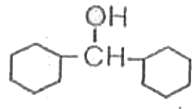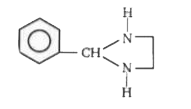Which one of the following compounds has the most acidic nature ?




The correct Answer is:B
To determine which compound has the most acidic nature among the given options, we need to analyze the structure and the electron-donating or withdrawing effects of each compound. Here’s a step-by-step breakdown of the solution:
Step 1: Understand Acidity
- Acids are substances that can donate a proton (H⁺ ion). The ease of proton donation is influenced by the stability of the resulting anion after proton donation.
- Electron-donating groups (EDGs) increase electron density on the hydroxyl group (–OH), making it harder to lose H⁺, thus decreasing acidity.
- Electron-withdrawing groups (EWGs) decrease electron density on the hydroxyl group, making it easier to lose H⁺, thus increasing acidity.
Step 2: Analyze Each Compound
1. Benzyl Alcohol (C₆H₅CH₂OH):
- The benzene ring has a weak electron-withdrawing effect (due to resonance) but the CH₂ group is electron-donating (due to +I effect).
- Overall, the electron-donating effect dominates, making it less acidic.
2. Phenol (C₆H₅OH):
- The –OH group is directly attached to the benzene ring, which can stabilize the negative charge on the oxygen through resonance.
- The benzene ring exerts a –R (resonance) effect, pulling electrons away from the –OH group, thus making it easier to lose H⁺.
- This makes phenol more acidic compared to benzyl alcohol.
3. Cyclohexanol (C₆H₁₁OH):
- The –OH group is attached to a saturated carbon in a cyclohexane ring.
- The cyclohexane ring is electron-donating (+I effect), which increases electron density on the –OH group, making it less acidic.
4. Aliphatic Alcohol (R-OH):
- Similar to cyclohexanol, aliphatic alcohols have –OH groups attached to saturated carbons.
- These groups also exhibit +I effects, making them less acidic due to increased electron density on the –OH group.
Step 3: Compare Acidity
- Benzyl Alcohol: Less acidic due to the dominance of +I effect from CH₂.
- Phenol: Most acidic due to resonance stabilization of the negative charge after losing H⁺.
- Cyclohexanol: Less acidic due to +I effect from the cyclohexane ring.
- Aliphatic Alcohol: Less acidic due to +I effect from the aliphatic carbon.
Conclusion
Among the compounds analyzed, Phenol (C₆H₅OH) has the most acidic nature due to the resonance stabilization provided by the benzene ring, which facilitates the loss of the H⁺ ion.
Final Answer
Phenol is the most acidic compound among the given options.
---
- Acids are substances that can donate a proton (H⁺ ion). The ease of proton donation is influenced by the stability of the resulting anion after proton donation.
- Electron-donating groups (EDGs) increase electron density on the hydroxyl group (–OH), making it harder to lose H⁺, thus decreasing acidity.
- Electron-withdrawing groups (EWGs) decrease electron density on the hydroxyl group, making it easier to lose H⁺, thus increasing acidity.
1. Benzyl Alcohol (C₆H₅CH₂OH):
- The benzene ring has a weak electron-withdrawing effect (due to resonance) but the CH₂ group is electron-donating (due to +I effect).
- Overall, the electron-donating effect dominates, making it less acidic.
- The –OH group is directly attached to the benzene ring, which can stabilize the negative charge on the oxygen through resonance.
- The benzene ring exerts a –R (resonance) effect, pulling electrons away from the –OH group, thus making it easier to lose H⁺.
- This makes phenol more acidic compared to benzyl alcohol.
- The –OH group is attached to a saturated carbon in a cyclohexane ring.
- The cyclohexane ring is electron-donating (+I effect), which increases electron density on the –OH group, making it less acidic.
- Similar to cyclohexanol, aliphatic alcohols have –OH groups attached to saturated carbons.
- These groups also exhibit +I effects, making them less acidic due to increased electron density on the –OH group.
- Benzyl Alcohol: Less acidic due to the dominance of +I effect from CH₂.
- Phenol: Most acidic due to resonance stabilization of the negative charge after losing H⁺.
- Cyclohexanol: Less acidic due to +I effect from the cyclohexane ring.
- Aliphatic Alcohol: Less acidic due to +I effect from the aliphatic carbon.
Among the compounds analyzed, Phenol (C₆H₅OH) has the most acidic nature due to the resonance stabilization provided by the benzene ring, which facilitates the loss of the H⁺ ion.
Phenol is the most acidic compound among the given options.
Topper's Solved these Questions
- ALCOHOLS, PHENOLS AND ETHERSBOOK - AAKASH INSTITUTE ENGLISHCHAPTER - ALCOHOLS, PHENOLS AND ETHERSEXERCISE - Assignment Section - C (Questions asked Prior to medical Ent. Exams. 2005)
13 Videos
- ALCOHOLS, PHENOLS AND ETHERSBOOK - AAKASH INSTITUTE ENGLISHCHAPTER - ALCOHOLS, PHENOLS AND ETHERSEXERCISE - Assignment Section -D (Assertion - reason type question)
20 Videos
- ALCOHOLS, PHENOLS AND ETHERSBOOK - AAKASH INSTITUTE ENGLISHCHAPTER - ALCOHOLS, PHENOLS AND ETHERSEXERCISE - Assignment Section - B (Objective type questions)
25 Videos
- ALCOHOLS, PHENOLS AND ETHERS BOOK - AAKASH INSTITUTE ENGLISHCHAPTER - ALCOHOLS, PHENOLS AND ETHERS EXERCISE - Try Yourself
5 Videos
Similar Questions
Knowledge Check
Which of the following compounds has most acidic hydrogen ?
A B
B C
C D
D
Which one of the following compounds is most acidic
View SolutionWhich of the following compounds is the most stable?
View SolutionWhich of the following compounds is most acidic ?
View SolutionWhich of the following compounds is most acidic ?
View SolutionWhich of the following compounds is most acidic ?
View SolutionAmong the following compounds the most acidic is
View SolutionWhich one of the following compounds possesses the most acidic hydrogen?
View Solution
